“Sharing is Caring”
Introduction
A design undertaken whilst participating in Carla’s Design Forum.
This design came about after a large glass of wine in the bath. I’ve been participating in some sessions discussing equity and equality, and these have made me consider more what I have, what I have in excess and what I could share. These thoughts led me to consider how I could best protect the work I’ve done on the land here to ensure it has the best chance of enduring after I am no longer able to look after the land I look after.
The title came about as it is something the children I work with often say, and it has stuck in my mind.
Dates
January 2023 –
Tools Used
Mind map, 5 Ws
Resources Used
Delvin Solkinson’s Permaculture Design Deck.
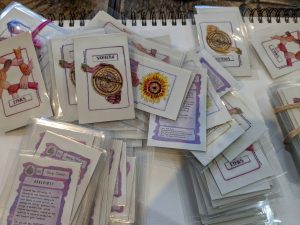
I have chosen to use the design deck to choose which tools, techniques, frameworks and ethics will guide this design. The deck is split into
- Ethics
- Attitudes
- Methods
- Design
- Strategies
At each point in the design, I will look through the cards, selecting one that seems appropriate or interesting.
Yields this project will provide
A clear picture of what I have that I am able to share with others.
A plan of how I can best protect the work I have put into my land
An exploration of different design techniques, tools and frameworks
Link to ALP and my personal objectives
Ethics
Ethics are central to this design. They are the point at which everything else rotates.
From the design deck I chose
Ethical Principles
Incorporate guidelines that encourage beneficial relationships, honour life and uphold freedom. Having Deep moral values of love and caring reflect the higher capacities of concious humans. Follow a code for respectful behaviour.
Rowe Morrow
Share Surplus to Need
Unused resources become pollutants. Sharing surplus energy and materials with each other and the planet cares for every species.
Rosemary Morrow
People Care
Everyone has the inherent right to have a healthy life with fundamental freedoms. Together we can redesign our world to address pressing planetary concerns around hunger, homelessness, disease, oppression and access to education.
Bill Mollison
Future Care
Future generations of people, animals and plants have a fundamental right to live in a world with healthy soil, air and water. A core aspect of the permaculture ethos is sharing fairly, limiting consumption and population, as well as reinvesting surplus in Earth care and People care.
Starhawk
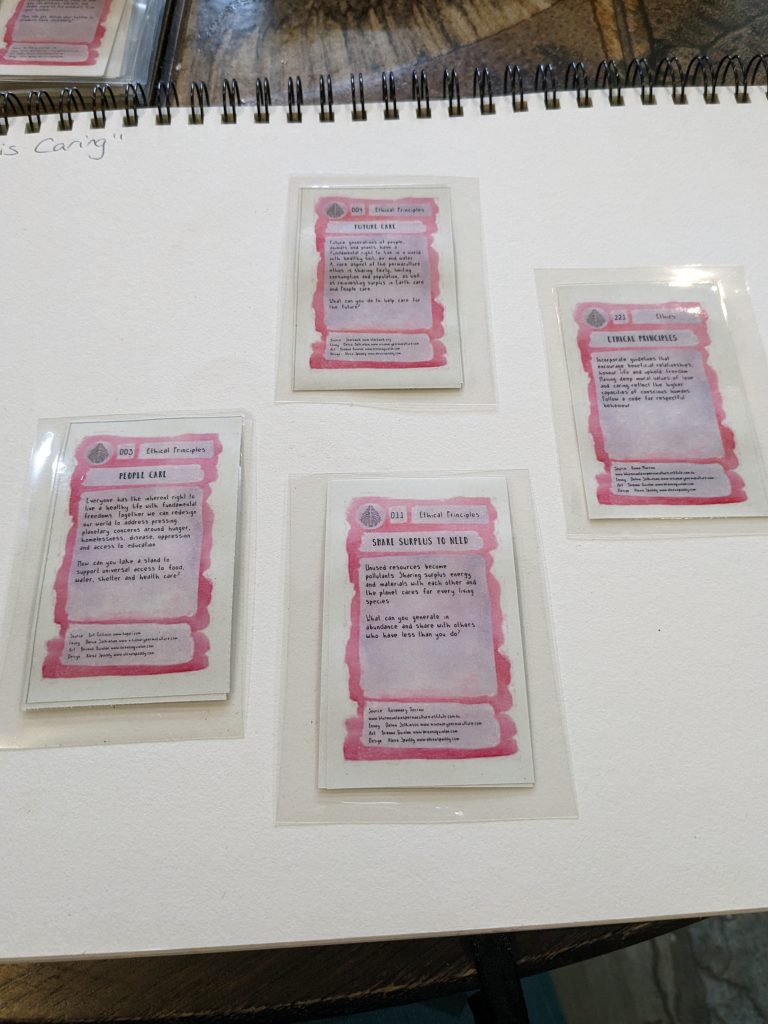
Design Framework
AEIOU – Activate, Explore, Inspire, Ownership, Undertake
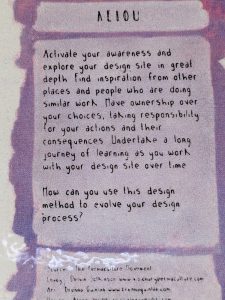
I chose this framework as I felt it lent itself to the exploratory nature of this design.
Activate your awareness
To begin, I grabbed the essentials, a Cuppa, a pencil and a large pad of paper.

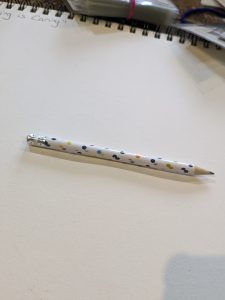
I carried out an initial mind map of where the ethics took me. From this I identified a number of areas I could explore further. I then considered each of the areas and gave them each a number. I will explore each of these areas in numerical order.
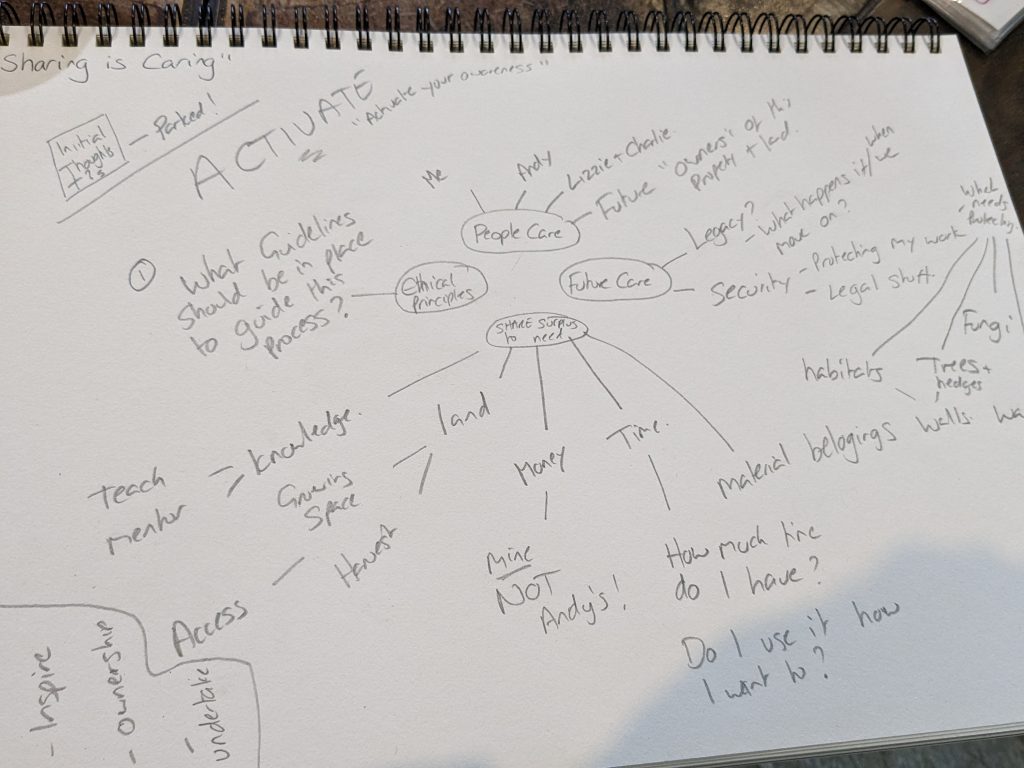
What guidelines should be in place to guide this process?
I used the 5 Ws (Why, What, Who, Where, When), to explore how I should guide this process
Why am I doing this?
- Position of privelege – Andy is the main earner and his income enables me to care for and work on the land, and in a couple of jobs that are worthwhile, but pay little. We own our home, and 4 acres of land.
- Four acres of land is a lot for one person, who also works, and has other commitments to manage.
- I have spent years implementing measures to increase bio-diversity. The land is home to UNHCR red list fungi species, and many plant and animal species.
- Is this just a vanity project to make me feel less guilty? – No. It needs to be workable, realistic and provide real benefits.
- I need to look at whether my time is being used in the best ways possible.
What will the end result look like?
- It will be considered by all people involved. I will seek their feedback and listen to their opinions.
- It will be logical, practical and considered
- It will be clear and quantifiable (where possible)
- There will be clear boundaries. Any financial changes will only impact my income (unless Andy specifically asks to participate financially). Nothing will be put in place unless all parties are happy for it to go ahead.
Who will be involved (or could be involved)
- Me, Andy and our children
- Local community groups
- Members of our local community
Where does this project have impact?
- Geographically, it is centred around our home and land, and possible our local community
- Politically – there may be impacts on future use of the land.
- Physically, the project will explore how I share myself (in terms of time, skills and knowlege)
When will this project see some return?
- It may never be fully implemented, but I will determine short term, medium term and long term targets.
From these considerations I defined 4 guidelines for this project
- My heart should not rule my head – be considered, non-judgemental and not impulsive
- Discuss plans, listen to feedback and opinions and have facts to back up any proposals.
- Be realistic
- Remember ‘The Turnip of Influence’
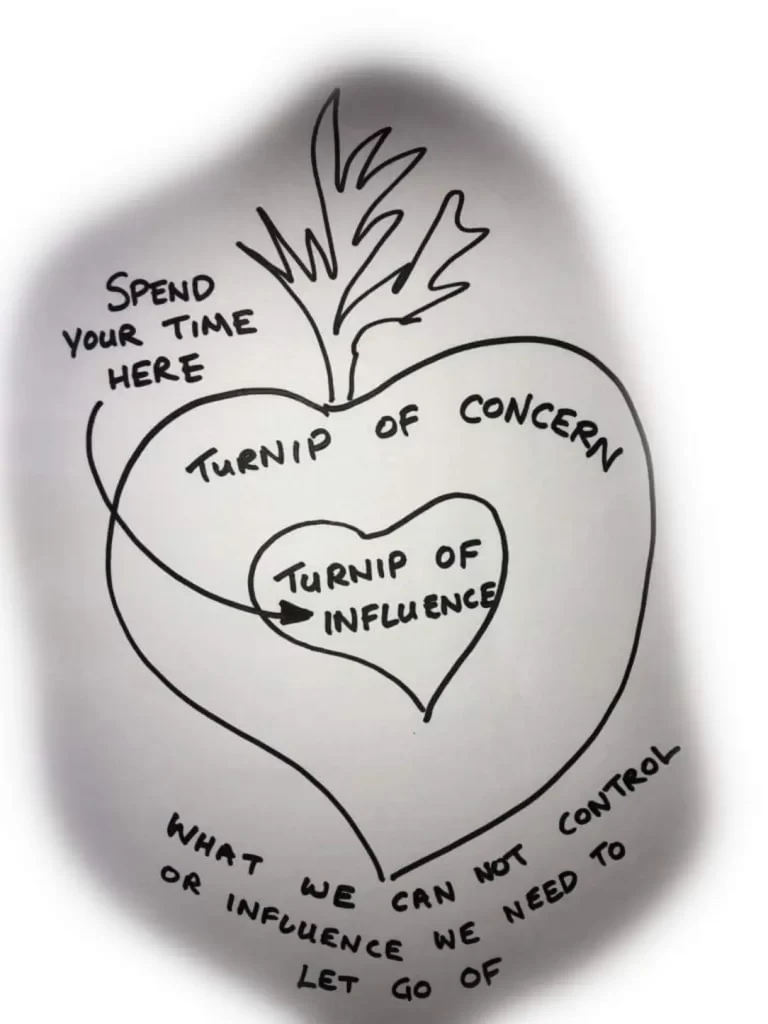
Explore (your design site in great depth)
Note: Use 6 Hats to look at areas 2 – 8. Ask the questions, research the options, consider the findings.
Inspire (Find inspiration from other places)
Research – who is sharing? How are people sharing? What mechanisms are in place?
Ownership (Take responsibility for my actions)
What do I (We) need to do to ensure we can support these decisions?
Undertake (a journey of learning as you work)
How will I ensure any desicions made are supported, and how will I know if they have been successful?